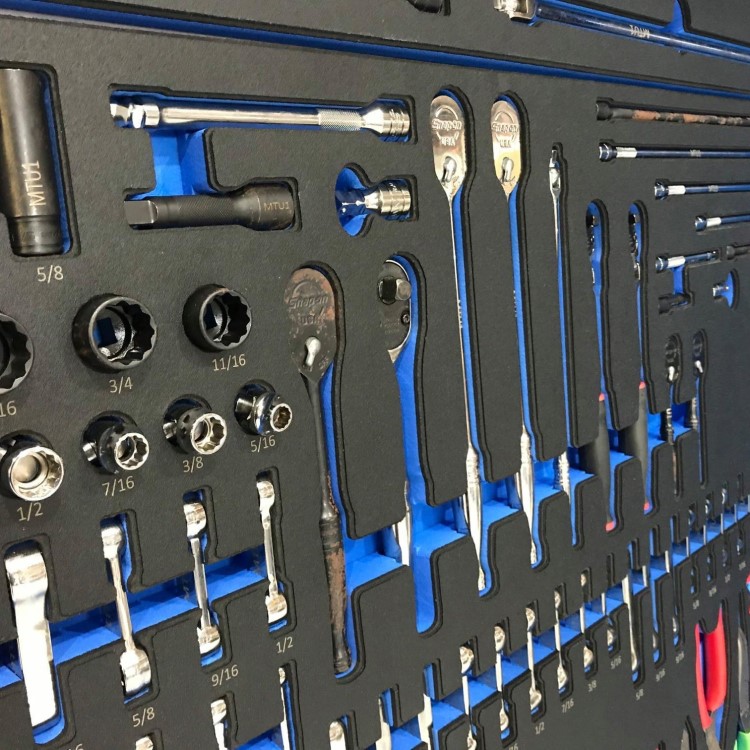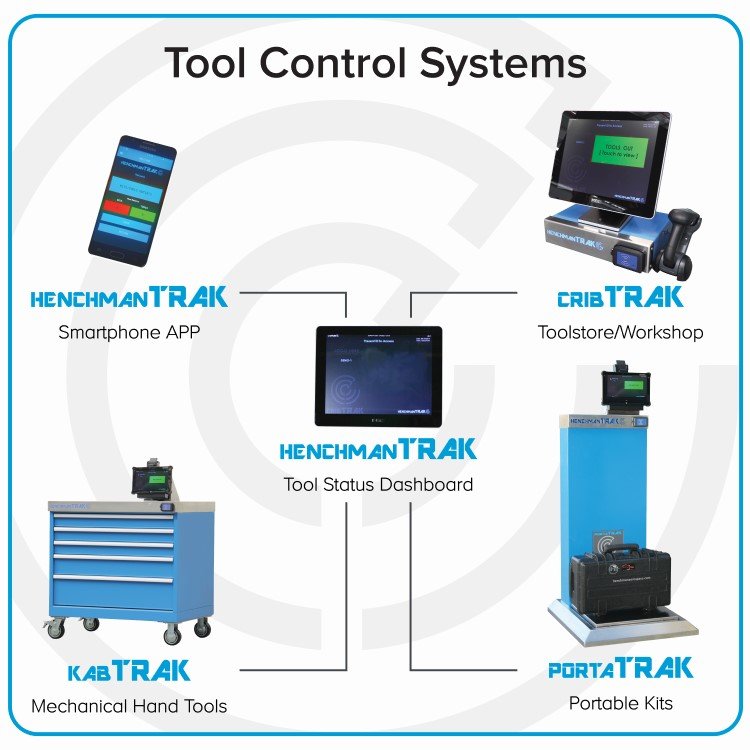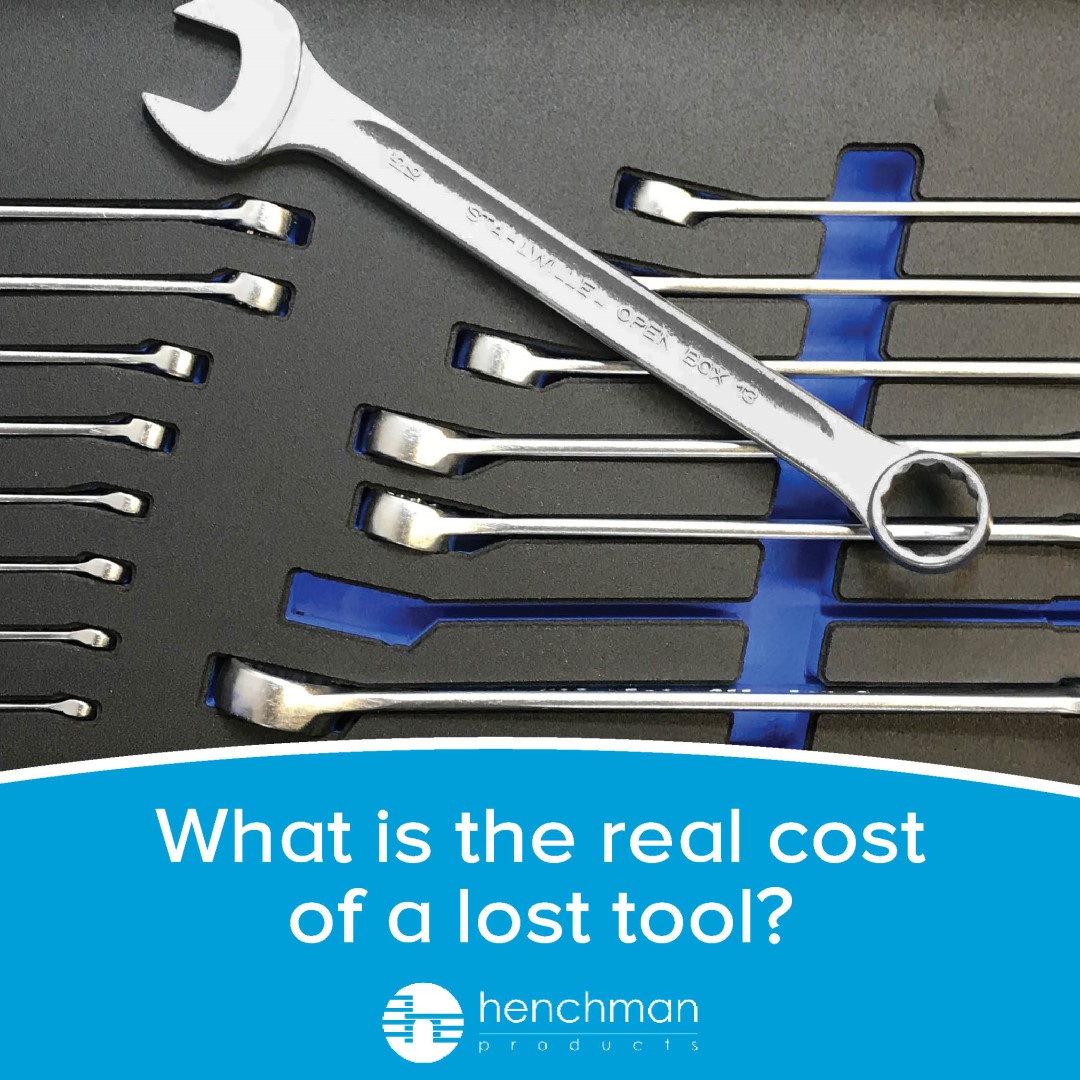|
Henchman |

|
|---|
What is the real cost of a lost tool?
Sep 15, 2021
What is the real cost of a lost tool?
Regardless if you are working in the aerospace, construction, field service, automotive or mining industry, leaving your tools in an open area or in an area where multiple people have access to them throughout the day, can lead to misplaced or lost tools on the job site.
Not being able to find tools when you need them is more than just an inconvenience. The time spent looking for them eats into the productivity of your organisation.
Simple maths tells us that if you spent only ten minutes per workday searching for your tools, this would add up to a full 40-hour work week in a year.
…and this got us thinking. What is the actual cost of losing a tool?
The cost of downtime
We did some research:
- According to a report from Ponemon Institute in 2016 the average cost of downtime is nearly $9,000 per minute. For small businesses, that number drops to the lower but still significant tune of $137 to $427 per minute.
- In 2016, the average cost of downtime across all businesses was $260,000 per hour. That was a 60% jump from 2014. (source)
- In some industries, the cost is considerably higher. In the automotive industry, downtime can cost up to $50,000 per minute, which equals $3 million per hour. (source)
- Even so, the true cost of downtime is unknown. Consultants believe that 80% of industrial facilities are unable to accurately estimate their downtime. A common estimate is that factories lose anywhere from 5% to 20% of their productivity due to downtime. (source)
- Human error causes 23% of unplanned downtime in manufacturing. That’s 2.5x higher than in other sectors. (source)
- Faulty equipment is another common cause of downtime. A 2017 survey found that 70% of companies lack complete awareness of when equipment is due for maintenance or upgrade. (source)
- The average cost of a downtime incident is about $17,000. (source)
As you can see, it’s difficult to come up with an exact figure as there are too many variables: duration of the downtime, number of people involved, reason for downtime, resources needed to fix the issue, lead time of new tools – to name a few!
We go into these in more detail below.
Factors that influence the cost of downtime
 Firstly, of course you will have the replacement cost of the item. Depending on the brand and type of tool, this can be quite expensive in itself.
Firstly, of course you will have the replacement cost of the item. Depending on the brand and type of tool, this can be quite expensive in itself.
Then you have the administrative cost for the time spend looking for the tool. This may actually be higher than you realise. Firstly, there would be a physical search. You would need to retrace your steps, spend unnecessary time searching and then potentially be unsuccessful.
You may need the team to help search for the tool. This would result in time away from their application/production tasks and will create a roll-on effect whereby other jobs won’t get finished in time.
Depending on your workplace processes, you may need to file a report regarding the lost tool to superiors, wasting their time and using up valuable production time. Remember, time is money!
In the aerospace industry, you would need to consider the possibility of the cost of grounded aircraft or downtime in production. Should the lost tool end up in the engine or other critical parts of the aircraft (we don't like to think of it) there is always the possible risk of catastrophic or fatal equipment failure. Even just the need to repair a scratch caused by an insert bit might already cost thousands and take a considerable amount of time.
And what about the time spent raising a new PO, the time procurement spends on sourcing the tool, delivery of the item (which can be quite significant for imported tooling), the time spent for calibration if required and/or laser marking for identification purposes?
Lastly, what about the reputation of your company or team if the job or processes get delayed? This cost is immeasurable, not only resulting in loss of future work, but also the loss of potential new clients. Negative reviews are having more and more of an impact in today’s consumer market.
The potential costs are monumental, it just isn’t worth the risk! Thankfully, here at Henchman we have a tried and proven system to eliminate the problem.
So, what’s the solution?
 The simplest solution is a Tool Control strategy. How this looks for your company will differ to the next (either Electronic or basic Visual Tool Control).
The simplest solution is a Tool Control strategy. How this looks for your company will differ to the next (either Electronic or basic Visual Tool Control).
For the more budget conscious, Henchman have supplied visual tool control solutions for over 20 years:
- Store your tools in kits or boards that have two-coloured foam cut outs for tools making it very easy to visually identify missing items
- Laser mark tools so it is easy to identify which kit/foam layer they belong to
- Have a tool list with each kit which can act as a checklist
- Implement tool tagging procedures i.e. when a tool is taken, employees leave a tag with their initials/details beside the tool slot. This saves a lot of time tracking tools down
- Have strict documented procedures regarding the issue and return of tools
In addition to lost tools, broken or poorly serviced tooling can also impact greatly on productivity and downtime. We recommend investing in quality tooling from the outset, and having an accurate system to record Calibration/Servicing. Having reminders sent ahead of time to help you schedule the service will prevent downtime due to a broken or inaccurate tool.
Taking it a step further
 Our Electronic Tool Control solutions HenchmanTRAK cut out the manual work and potential for human error by automating all of the above-mentioned steps. The HenchmanTRAK solution includes an entire family of systems to completely cover your needs which includes:
Our Electronic Tool Control solutions HenchmanTRAK cut out the manual work and potential for human error by automating all of the above-mentioned steps. The HenchmanTRAK solution includes an entire family of systems to completely cover your needs which includes:
- Electronic automated toolboxes - kabTRAK
- Weight based system for managing portable tool kits - portaTRAK
- Smart locker systems to help with issuing and returning tool kits from an unattended remote site - lokkaTRAK
- A smartphone app with bluetooth locks to bring tool control right into the field
- A manual barcode scanning tool control system to help manage issuing and returning tools, consumables and GSE from the toolcrib - cribTRAK
Some of the benefits of going with electronic tool control over a simple tool tagging process are:
- More efficient and secure way to ensure each tool is issued to an engineer and returned correctly without skipping the process.
- Extra level of accountability with regards to issuing and returning "sets" and calibrated items.
- Automating the process will provide you with reporting capability.
- The ability to check the status of a toolbox remotely.
- Time stamp when a tool is issued, this could help in the case of a tool going missing to help in figuring out what specific task was being done at this time.
- Efficient way to mark tools as unserviceable and prevent them being used by another user.
- Will help in the case of tracing what aircraft a tool has been used on if found to be out of tolerance or not functioning correctly.
- Removing the need for tags which are a FOD issue in themselves.
- Reduce the risk of tool sharing as each user is required to return his own tools.
- Will enforce the tool control culture as you can’t skip the process. However the system is not in any way a hinderance to the speed in which a tool can be issued or returned.
- The system provides a way to set a "next calibration date" and doesn't allow the tool to be issued without an administrator confirming the calibration is complete and entering a new calibration date.
- In addition to saving money by preventing downtime, you’ll also save money by reducing time spent on administrative tasks like manually signing tools in/out and scheduling reminders for calibration.
To sum it up
 Nothing can completely prevent a misplaced tool or human error. But there are many things you can do to minimise the risk of material failure and lost equipment in order to prevent expensive downtime. Henchman specialises in coming up with the perfect system for your company, be it basic and straightforward, or detailed and electronic.
Nothing can completely prevent a misplaced tool or human error. But there are many things you can do to minimise the risk of material failure and lost equipment in order to prevent expensive downtime. Henchman specialises in coming up with the perfect system for your company, be it basic and straightforward, or detailed and electronic.
That cold beer is calling, so let us help you leave work on time, every night!






